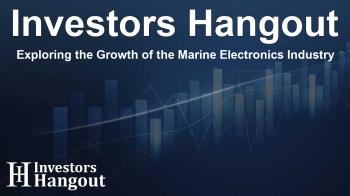Exploring the Growth of the Marine Electronics Industry

The Future of Marine Electronics: Market Insights
The marine electronics market is poised for substantial growth, projected to expand by USD 1.82 billion from 2025 to 2029, driven by the increasing adoption of GPS technologies and innovative applications in the field. According to market analysts, this growth represents a compound annual growth rate (CAGR) of over 5.3% during the forecast period. This optimistic outlook indicates that companies in the marine electronics industry are actively seeking strategic partnerships to enhance their market presence.
Understanding Market Dynamics
This market is highly fragmented, and numerous vendors are stepping up to meet the growing demand for advanced marine technologies. Leading players include prominent names like Garmin, Furuno Electric, and Raymarine, to name a few. These companies are striving to stay competitive by integrating cutting-edge technology into their products. Moreover, the demand for high-performance electronics solutions in marine vessels, such as radar displays and sonar systems, is increasing steadily, thereby presenting significant opportunities for market growth.
Drivers of Market Growth
The continued growth in the marine electronics market can be attributed to various factors. The surge in demand for advanced systems like radar displays and VHF radios for effective communication and navigation in diverse environmental conditions highlights the critical role these technologies play in ensuring maritime safety. Moreover, satellite transmission and ship tracking solutions are redefining the landscape by providing real-time information and enhancing operational efficiency for various marine applications.
Challenges in the Marine Electronics Sector
Despite the encouraging growth prospects, companies in this sector face certain challenges. High costs associated with sonar systems can hinder widespread adoption among smaller maritime operators. Furthermore, issues related to wiring, calibration, and ensuring waterproof designs suitable for harsh marine environments also pose obstacles to manufacturers. Addressing these challenges effectively will be paramount for organizations aiming to tap into this lucrative market.
Market Segmentation Overview
The marine electronics market comprises various segments, including recreational boats, merchant shipping vessels, and fishing vessels. Each category presents unique requirements and opportunities. For instance, recreational vessels primarily seek electronics for navigation, automation, and entertainment, such as GPS devices and chart plotters. In contrast, commercial shipping heavily relies on systems for navigation and vessel management. Fishing vessels are increasingly incorporating sonar technology and fishing software to improve their operations.
Hardware vs. Software Components
The marine electronics market is largely driven by hardware components, which include essential tools like marine VHF communication devices, thermal cameras, and autopilots. As technology evolves, the segment has seen an increasing adoption of sophisticated GPS systems necessary for the efficient operation of vessels. Additionally, software applications integrated with marine hardware play a vital role in enhancing operational capabilities.
Regional Market Dynamics
When examining geographic trends, North America leads the market, contributing a significant portion of the industry share. Meanwhile, regions like Asia-Pacific and Europe are also witnessing rapid growth, driven by the rising number of vessels and the need for advanced electronics systems. Countries across these regions are investing substantially in upgrading their marine fleets, which augments the demand for innovative solutions.
Looking Ahead: Trends and Predictions
In light of emerging trends, the marine electronics market is expected to continue evolving with advancements in technology. Notably, the development of autonomous marine vehicles and improved SONAR systems promises to reshape operational capabilities within the industry. Companies that can innovate and adapt their offerings in line with these trends will likely see significant benefits in terms of market share and customer loyalty.
Frequently Asked Questions
What factors are driving growth in the marine electronics market?
The growth is driven primarily by the increasing demand for advanced navigation technology, effective communication systems, and safety solutions for marine vessels.
What challenges do companies face in the marine electronics industry?
Organizations face challenges such as high costs associated with advanced systems and the need for durable, waterproof designs for saltwater environments.
How segmented is the marine electronics market?
The market is highly segmented, encompassing recreational boats, merchant vessels, and fishing vessels, each with specific technological requirements.
Which regions dominate the marine electronics market?
North America holds a significant share of the market, with rapid growth also occurring in Asia-Pacific and Europe.
What is the projected CAGR for the marine electronics market?
The marine electronics market is projected to grow at a CAGR of over 5.3% during the forecast period from 2025 to 2029.
About The Author
Contact Dominic Sanders privately here. Or send an email with ATTN: Dominic Sanders as the subject to contact@investorshangout.com.
About Investors Hangout
Investors Hangout is a leading online stock forum for financial discussion and learning, offering a wide range of free tools and resources. It draws in traders of all levels, who exchange market knowledge, investigate trading tactics, and keep an eye on industry developments in real time. Featuring financial articles, stock message boards, quotes, charts, company profiles, and live news updates. Through cooperative learning and a wealth of informational resources, it helps users from novices creating their first portfolios to experts honing their techniques. Join Investors Hangout today: https://investorshangout.com/
The content of this article is based on factual, publicly available information and does not represent legal, financial, or investment advice. Investors Hangout does not offer financial advice, and the author is not a licensed financial advisor. Consult a qualified advisor before making any financial or investment decisions based on this article. This article should not be considered advice to purchase, sell, or hold any securities or other investments. If any of the material provided here is inaccurate, please contact us for corrections.

